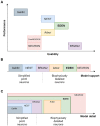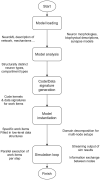EDEN: A High-Performance, General-Purpose, NeuroML-Based Neural Simulator
- PMID: 35669596
- PMCID: PMC9167055
- DOI: 10.3389/fninf.2022.724336
EDEN: A High-Performance, General-Purpose, NeuroML-Based Neural Simulator
Abstract
Modern neuroscience employs in silico experimentation on ever-increasing and more detailed neural networks. The high modeling detail goes hand in hand with the need for high model reproducibility, reusability and transparency. Besides, the size of the models and the long timescales under study mandate the use of a simulation system with high computational performance, so as to provide an acceptable time to result. In this work, we present EDEN (Extensible Dynamics Engine for Networks), a new general-purpose, NeuroML-based neural simulator that achieves both high model flexibility and high computational performance, through an innovative model-analysis and code-generation technique. The simulator runs NeuroML-v2 models directly, eliminating the need for users to learn yet another simulator-specific, model-specification language. EDEN's functional correctness and computational performance were assessed through NeuroML models available on the NeuroML-DB and Open Source Brain model repositories. In qualitative experiments, the results produced by EDEN were verified against the established NEURON simulator, for a wide range of models. At the same time, computational-performance benchmarks reveal that EDEN runs from one to nearly two orders-of-magnitude faster than NEURON on a typical desktop computer, and does so without additional effort from the user. Finally, and without added user effort, EDEN has been built from scratch to scale seamlessly over multiple CPUs and across computer clusters, when available.
Keywords: High-Performance Computing; NeuroML; biological neural networks; code morphing; computational neuroscience; interoperability; simulation; software.
Copyright © 2022 Panagiotou, Sidiropoulos, Soudris, Negrello and Strydis.
Conflict of interest statement
The authors declare that the research was conducted in the absence of any commercial or financial relationships that could be construed as a potential conflict of interest.
Figures










Similar articles
-
The NeuroML ecosystem for standardized multi-scale modeling in neuroscience.Elife. 2025 Jan 10;13:RP95135. doi: 10.7554/eLife.95135. Elife. 2025. PMID: 39792574 Free PMC article.
-
NeuroML: a language for describing data driven models of neurons and networks with a high degree of biological detail.PLoS Comput Biol. 2010 Jun 17;6(6):e1000815. doi: 10.1371/journal.pcbi.1000815. PLoS Comput Biol. 2010. PMID: 20585541 Free PMC article.
-
NeuroML-DB: Sharing and characterizing data-driven neuroscience models described in NeuroML.PLoS Comput Biol. 2023 Mar 3;19(3):e1010941. doi: 10.1371/journal.pcbi.1010941. eCollection 2023 Mar. PLoS Comput Biol. 2023. PMID: 36867658 Free PMC article.
-
Towards NeuroML: model description methods for collaborative modelling in neuroscience.Philos Trans R Soc Lond B Biol Sci. 2001 Aug 29;356(1412):1209-28. doi: 10.1098/rstb.2001.0910. Philos Trans R Soc Lond B Biol Sci. 2001. PMID: 11545699 Free PMC article. Review.
-
Code Generation in Computational Neuroscience: A Review of Tools and Techniques.Front Neuroinform. 2018 Nov 5;12:68. doi: 10.3389/fninf.2018.00068. eCollection 2018. Front Neuroinform. 2018. PMID: 30455637 Free PMC article. Review.
Cited by
-
Efficient implementation of the Hodgkin-Huxley potassium channel via a single volatile memristor.Front Neurosci. 2025 Jul 18;19:1569397. doi: 10.3389/fnins.2025.1569397. eCollection 2025. Front Neurosci. 2025. PMID: 40757371 Free PMC article.
-
The NeuroML ecosystem for standardized multi-scale modeling in neuroscience.Elife. 2025 Jan 10;13:RP95135. doi: 10.7554/eLife.95135. Elife. 2025. PMID: 39792574 Free PMC article.
-
NESTML: a generic modeling language and code generation tool for the simulation of spiking neural networks with advanced plasticity rules.Front Neuroinform. 2025 Jun 4;19:1544143. doi: 10.3389/fninf.2025.1544143. eCollection 2025. Front Neuroinform. 2025. PMID: 40535463 Free PMC article.
-
Brian2CUDA: Flexible and Efficient Simulation of Spiking Neural Network Models on GPUs.Front Neuroinform. 2022 Oct 31;16:883700. doi: 10.3389/fninf.2022.883700. eCollection 2022. Front Neuroinform. 2022. PMID: 36387586 Free PMC article.
-
DendroTweaks: An interactive approach for unraveling dendritic dynamics.bioRxiv [Preprint]. 2024 Sep 10:2024.09.06.611191. doi: 10.1101/2024.09.06.611191. bioRxiv. 2024. PMID: 39314451 Free PMC article. Preprint.
References
-
- Akar N. A., Cumming B., Karakasis V., Küsters A., Klijn W., Peyser A., et al. . (2019). Arbor – A morphologically-detailed neural network simulation library for contemporary high-performance computing architectures, in 2019 27th Euromicro International Conference on Parallel, Distributed and Network-Based Processing (PDP) (Pavia: ), 274–282. 10.1109/EMPDP.2019.8671560 - DOI
LinkOut - more resources
Full Text Sources
Miscellaneous

